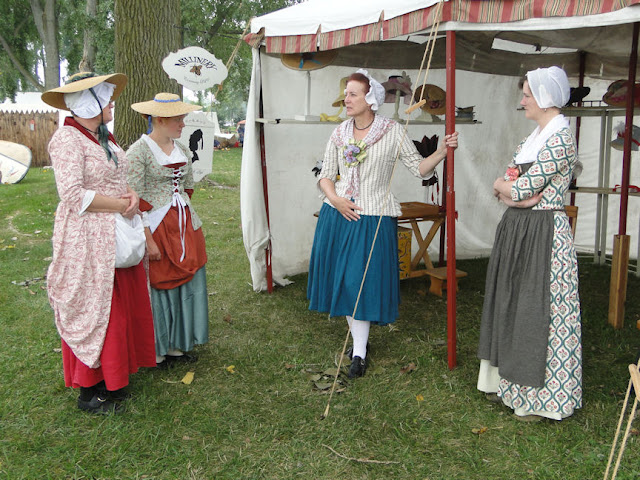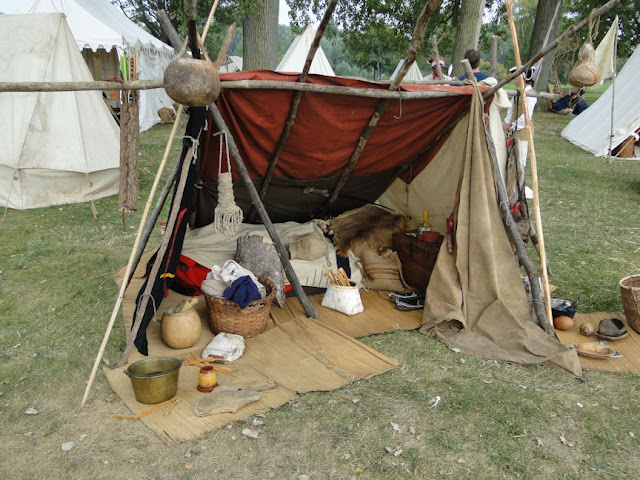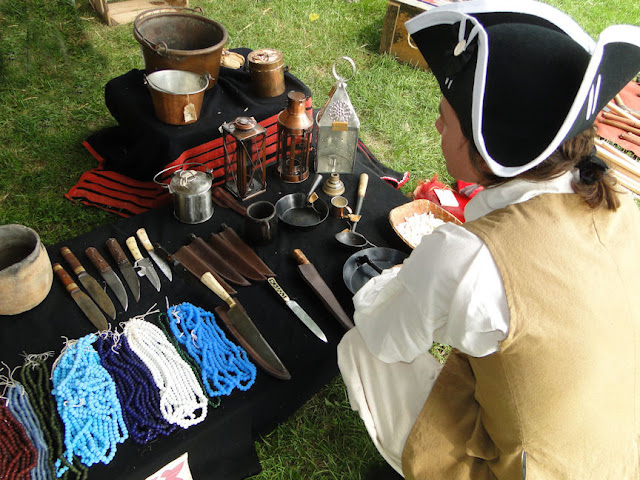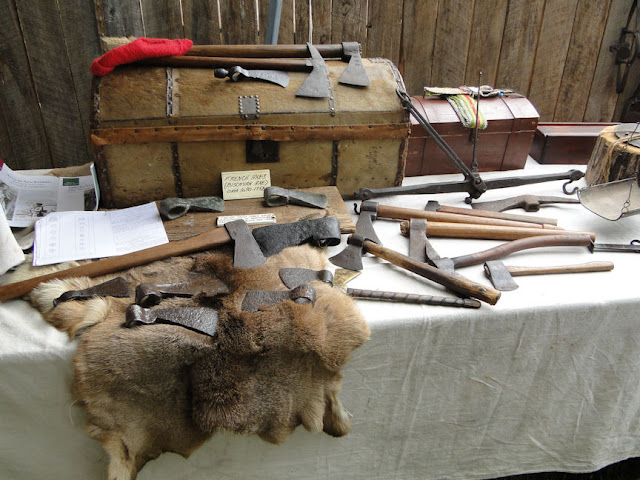My reenacting horizon is ever growing...growing wider and wider...into realms I never imagined...
Although I've been a true lover and researcher of history for most of my life, the world of time-travel first opened up to me back in the mid-1990s when I took part in the Holly Dickens Festival where I became a Dickensian character to help bring to life the era of Charles Dickens 1843 "A Christmas Carol."
Though not reenacting (it was more street theater), it was, for me, the catalyst for all future-past excursions to come - it gave me the want to dress in period clothing beyond Christmas and continue to bring history to life throughout the year. So I began to do presentations for my local historical society, then met and fell in with the 21st Michigan Civil War group, which I am still very much a part of, and, more recently, have added the Revolutionary War period of American history to my living history resume'.
Bringing the past to life indeed!
But Michigan, my home state, has a very different history attached to it than, say, Massachusetts; we have a group of fur traders called The Ste. Claire Voyageurs, a group of adventurers who are unique to this general
region of southeastern Michigan and what is now Ontario, Canada. The Voyageurs were Great Lakes fur traders, missionaries, and
explorers that came to the area in the early 1600's. They were of French
origin, though they did not come directly from France. Rather, they came from
the large French settlements in Montreal and Quebec. From the 1670s
until the 1800s, these fur traders and homesteaders started settling in the
Macomb County area of Michigan, not too far north of Detroit (founded in 1701). I find this very
interesting since Macomb is the county in which I have lived nearly my entire
life.
The
Voyageurs befriended, learned from and intermarried with the local Indians who
were already here when they arrived. They built earthen huts and farmed
"strip farms," which were long pieces of land beginning at the narrow
end near the lake and extended inland for about a half mile with a width of
about 500 feet. In this way they were able to take full advantage of the
natural waterways of the Detroit and St. Clair Rivers as well as Lake St. Clair
itself.
The
Voyageurs were known for buying, selling and trading animal fur and pelts. They
adapted the Indian-style canoes and bateaux (a small, flat-bottomed rowboat
used on rivers) to move their furs, as well as using sailboats.
Now, in the 21st century, the Ste. Claire Voyageur reenactors/living historians recreate this life from the 17th, 18th, and early 19th centuries. I have visited their encampments numerous times over the years and have befriended a few of these fine folk. And this year of 2015, for the first time, I got to participate in one of their reenactments. No, I'm not claiming to be a Voyageur, for I do remain an 18th century east coast colonist. But I was invited to take part and to share my knowledge of this period in time, and I was honored to do so. It was quite different to be among this unique group of living historians, and they welcomed me with open arms.
The Voyageur reenactors really do a great job teaching the history connected with the original Voyageurs, Coureur de bois (French/Indian trapper of the Great Lakes), early settlers, and military of the Great Lakes fur trade era. Their living history reenactments of the lifestyles and skills of the region include demonstrations and displays of canoe building, traditional crafts and skills, trade goods and artifacts, blacksmithing, campfire cooking, cannons and weaponry. They also play music, dance, tell stories, give lectures and just do a fine job teaching about the general history of this long ago culture - a part of American history greatly over-looked.
Naturally, as I moved among the traders, I had my hidden camera ready at a moment's notice to snap a piece of history not shown very often in other parts of the U.S., and I would like to share them with you. There are quite a few photos here, so sit back and relax. There are some interesting stories to be told:Now, in the 21st century, the Ste. Claire Voyageur reenactors/living historians recreate this life from the 17th, 18th, and early 19th centuries. I have visited their encampments numerous times over the years and have befriended a few of these fine folk. And this year of 2015, for the first time, I got to participate in one of their reenactments. No, I'm not claiming to be a Voyageur, for I do remain an 18th century east coast colonist. But I was invited to take part and to share my knowledge of this period in time, and I was honored to do so. It was quite different to be among this unique group of living historians, and they welcomed me with open arms.
The Voyageur reenactors really do a great job teaching the history connected with the original Voyageurs, Coureur de bois (French/Indian trapper of the Great Lakes), early settlers, and military of the Great Lakes fur trade era. Their living history reenactments of the lifestyles and skills of the region include demonstrations and displays of canoe building, traditional crafts and skills, trade goods and artifacts, blacksmithing, campfire cooking, cannons and weaponry. They also play music, dance, tell stories, give lectures and just do a fine job teaching about the general history of this long ago culture - a part of American history greatly over-looked.
 |
| Two worlds meeting...and getting along. |
 |
| Normally we only hear of the Western and Plains Indians, so seeing those who once lived in my local area was very cool indeed. |
 |
| Within a lodge of broken bark the tender Babe was found A ragged robe of rabbit skin enwrapped His beauty round The chiefs from far before Him knelt With gifts of fox and beaver pelt |
 |
| O children of the forest free, O sons of Manitou The Holy Child of Heaven and Earth is born today for you Come kneel before the radiant Boy Who brings you beauty, peace and joy |
 |
| The canoes of the Voyageurs typically were made from the bark of large paper birch trees stretched over a white cedar frame. There were several sizes available for use, two common sizes, the larger (approximately 36-foot long) "Montreal Canoe" and the approximately 25-foot long "north canoe". The Montreal canoe was used on the Great Lakes, and the north canoe was used on the interior rivers. |
 |
| Home is where your canoe is. |
 |
| Practice your hatchet throwing here. |
The pathway along Lake St. Clair was lined with tents, and I met up quite a few people whose fashions were quite interesting indeed. You see, the mixing of Indian and European cultures seeped over into the clothing fashion, and it's interesting to note the more adventurous styles that came out of the blend, though we still will find the more traditional fashions in both camps.
 |
| There's just something about period music played on a hammered dulcimer and fiddle. I have numerous tunes in my CD collection, but hearing it live is all the better, and these two were excellent. |
 |
| No matter the age or the gender, chores needed to be done, including chopping wood, as this young lady shows. |
 |
| One of the Voyageurs |
 |
| Ahh...here's my old friend Joe Flatlander (aka as Glenn!). Joe, besides being one of the nicest guys you'd ever want to meet, is also a fine blacksmith as well. |
 |
| The Chaplain |
 |
| The milliner |
As I continued moving along, I found some fine period displays in front of many of the tents.
 |
| This gentleman had a fine collection of medical tools. He is the grandfather of the young guy you see sitting behind. Another generational reenacting family. |
 |
| I thought this lean-to had a great primitive, very 'woodsy' look to it. I've seen sketchings of 19th century frontiersmen using similar styles. |
 |
| Here are a few things you may need as a Voyageur, including snow-shoes (on the right). |
 |
| Handmade pipes from horn, clay, and bone. |
 |
| You may also need knives and lanterns. |
Let's head into the trading post:
 |
| Plenty of trading did go on between the Indians and the Voyageurs. Guns were a top priority for the natives. |
 |
| The proprietor of the Trading Post |
 |
| Here are the guns, ready to be traded for pelts. |
 |
| Powder horns |
 |
| Cast iron and copper pots, bottles, trunks, and even a foot warmer for your lady. |
 |
| The hatchets and axes are, perhaps, the most important tool a Voyageur could have, aside from his musket. Trunks are good to have, too. |
 |
| Remember that large canoe a few photos up? Yes, can you help me load my goods on to it? |
The next few photos show a few of the many crafters working their trade. The people here were very knowledgeable and happily explained what they were doing.
 |
| Here is a woodworker sitting on his shaving horse carving a block of wood into a canoe paddle. |
 |
| It was fascinating to watch as he expertly worked his craft. |
 |
| It did not take him very long before it was completed. He's pretty close to being done in this picture. |
 |
| Meet Mr. Jim Strode, pewterer. As he advertises, he makes "the finest of hard metal pewter." |
 |
| At the top we see a newly formed pewter spoon still in the spoon mold. Below that is the spoon mold itself. At the bottom is a spoon directly out of the mold, waiting to be smoothed and filed. |
 |
| The finished product. Yes, he sells what he makes and makes what he sells. They truly are a beautiful work of art. |
 |
| Mr. Strode also makes pewter buttons from his button mold. I believe the mold pictured here is an antique. |
 |
| There were numerous styles of looms about. Here is, I believe, a type of lap loom. |
 |
| Ross Grover makes a belt with a tape loom. |
 |
| I believe this woman used the lap-loom seen here to make the belts you see in the following photograph: |

 |
| Mrs. Paladino and Mrs. Grover are hand-making cording for bodice lacing, petticoat ties, etc. |
 |
| This young lady was a master at using the drop spindle. |
 |
| And I believe this is her mother using a spinning wheel and showing some of the wool she has spun into yarn. |
As I wandered through the village, I came across this woman who had "brain-tanned" a hide using traditional Indian methods. By the time I had taken the following photos, the early parts of this process were already completed, but it's something I've read about but had rarely gotten to see.
After returning home that evening I looked it up and found the gist of what she said on a brain-tanning site called Native Art in Canada written by an Ojibwa elder, who explained the process:
Brain tanning hides is a lot of
work. It's a very labor intensive process that uses an emulsified
solution of animal brain and water to provide outstanding absorbancy to the
final product. But what you get at the end of your sweat and toil is an exceptionally
soft hide that stays pliable even after it gets wet. Nevertheless, the process
of tanning hides by hand using the animal's brains, is not for the feint of
heart.
At the end of a hunt there's
usually no time to tan a hide because the priority is to process and preserve
the meat. At this point, we used to tie the hides in a bundle and string
them high up in a tree safe from scavengers...not porcupines, though!
When they were removed from storage they were often dirty...and always smelly.
When the time comes to begin the
brain tanning process, you have to first soak the skins in water for a few days
to clean and soften them. If you have access to a handy dandy lake then that's
the easiest way to go. City bred wives tend to fret if they find you've
taken over the bathtub for this purpose, so if a lake isn't close by, call on
your creative side.
Then, without doing damage to the
rawhide itself, you're going to have to scour the skin to remove bits of flesh
and fat. This first fleshing can be done over a wide log using a carved leg
bone as a scraper.
Using your bone or steel scraper
remove the grain. The grain is the name given to that part of the skin
where the hair grows. You have to work hard and be sure that you scrape
off every last bit of grain because otherwise your hide will be stiffer than it
should be and won't take the smoke evenly later.
When you're sure you've got rid of
the grain spread the hide out in the sun to dry...it won't take too long.
Drying helps with the next step.
Now it's time to turn your
attention to the inside of the hide. You're going to scrape off the
membrane layer which is where the blood vessels are. Before you start you
have to wet the hide again. Soak the hide for about fifteen minutes in
the handy dandy lake.
Place the hide back over the log
and methodically scrape off the membrane. If you leave any in place the
finished hide will be stiff and won't accept the smoke in the tanning
process. The point is to end up with a hide that doesn't have any holes
or knicks, so any scraping is best done with a deer leg bone or a blunt iron
flesher. The tanner's aim at this point is to remove every...EVERY... bit of
flesh and fat, including the paper thin epidermal layer between the carcass and
the outer hide.
When you think you've done an
excellent job you have to find a way to rinse the hide in running water
overnight. It takes a LOT of rinsing. Said lake would do the trick,
but a creek would be better. If the hide is small you could put it in a
five gallon pail and run a stream of water from a hose all night long.
You're trying to get to the point
where your hide feels loose and thin. It will take awhile and at first
will seem to get thicker so don't fret. Just keep rinsing. Worse
case scenario is that you'll have to do fling it over the log again for more
scraping time.
Next morning wring the hide
thoroughly. Rig up a wringer on a deck railing or heavy tree branch and
ask a friend for help if its a big hide. You have to wring in one
direction, then the other.
Some animal hides are better suited
for one purpose than another. Deer and moose make useless rugs, but great
footwear. Wolf and fox fur stand up to some abuse and are also good for
embellishing clothes. Rabbit skins can be tanned but are either ornamental or
cut into strips and knit or woven into a jacket or cape.
If you want the hair to remain on
the hide, of course you don't have to follow through with any of the procedures
that loosen the hair. But when you come to the bit about applying the brain
slurry you're going to have to be extra careful so that its only applied on one
side.
 |
| The finished product - all done in the traditional way. |
The woman you see in the above photos explained the entire process for me as I filmed her (click the arrow below to watch and listen):
Keeping the historical long-lost crafts alive is so important, and the Voyageurs do an amazing job in this field.
As I mentioned earlier, the Voyageurs were Great Lakes fur traders, missionaries, and explorers, and were known for buying, selling and trading animal fur and pelts. They adapted the Indian-style canoes and befriended, learned from and intermarried with the natives who were already here when they arrived.
The reenactors put on a pretty amazing trading scenario. In the video clip above you saw a little of the canoe ride - here are the photographs that also tell the story:
 |
| Taking off from camp, the Voyageurs will travel by water to trade with a local Indian tribe. |
 |
| Out into Lac Ste. Claire (Lake St. Clair) they go. |
 |
| The camp spotted, they head toward land. |
 |
| The Chaplain says a prayer in hopes the trading goes well. |
 |
| Recognize the woman in blue? Yep - she's the very kind person who gave us a lesson on brain-tanning hide! |
 |
| There were all kinds of item available for bartering. |
 |
| Knives, guns, blankets... |
 |
| It was very interesting to watch the living historians as they depicted what it was like to trade between the Indians and the white man. |
 |
| The quality of each participant was top notch. |
 |
| Trading complete, it was time to head back to their village. |
Not only was this my first time participating in this event, but it was my first time ever going to it. Normally it takes place the same weekend as the Civil War Muster in Jackson (Michigan), but this year, for some unknown reason (and lucky for me!), Jackson took place the previous weekend.
Hey! Hey! That left Voyageur weekend open!
As I continue to do 18th century events, I am getting more comfortable being "in that era," and I am finding that I am immersing myself a bit more each time out. I'm also finding that there is such a variety of styles in not only clothing, but in reenacting the era. It was interesting to compare the RevWar "eastern"/patriots style like at Kensington a few weeks back to this Voyageur frontier/French/Indian style - -
And what is really impressive about the Voyageurs is seeing all of the traditional crafts that they do.
Now, if you ask me to compare Colonial-era reenacting to Civil War reenacting, well, that is an idea for a future blog posting, for there are some very distinct differences.
I really enjoy both.
Anyhow, I hope you enjoyed my little excursion to a place one doesn't think of very often when they think of American life in the 18th century.
~ ~ ~ ~ ~ ~ ~ ~ ~
One more thing before I take my leave:
this same weekend, on the other side of town in Dearborn, occurred an event that I, unfortunately, could not attend called "We Humble Ourselves - Turning a Nation Back to God,"
which was a patriotic concert/ceremony featuring a symphony orchestra, a choral group, a
drum and fife corps, and living historians representing historical figures showing something that many in our modern times seem to deny - this nation's Christian heritage.
Whether or not you agree that we were a Christian nation, you cannot deny that this country has had a strong Christian heritage, and that's what this reenactment wanted to show.
Whether or not you agree that we were a Christian nation, you cannot deny that this country has had a strong Christian heritage, and that's what this reenactment wanted to show.
"As a congregation that not only loves the Lord, but rejoices in
the freedoms upon which our nation was forged, we look forward to standing
together in and through this unique event to celebrate these two extraordinary
loves of God and country."
The historical figures included:
Our First Fathers (William Bradford),
Our Founding Fathers (George Washington, Benjamin Franklin, Thomas Jefferson, John Jay,
and John Adams),
and
Our Uniting Fathers (Abraham Lincoln and Frederick
Douglass).
The audience was encouraged to dress
in Colonial or Civil War clothing for the Event, which many did.
“Our goal is to bring joy, hope,
and encouragement to a weary people and a struggling nation. Ultimately, we
rely on the promise of God as relayed in 2 Chronicles 7:14: If my
people who are called by my name will humble themselves, and pray and seek my
face and turn from their wicked ways, then I will hear from Heaven and I will
forgive their sin and will heal their land. Let
us rebuild our beloved City, State and Nation.”
From my friends that attended, they said it was an amazing - truly breathtaking - moment.
What follows here are a couple of pictures that were taken by those who were there:
By the way, if you are interested in learning about every day colonial life for (mostly) townsfolk, click HERE
Til next time, see you in time.
.



















2 comments:
Thank you for posting this. I would love to get into re-enacting although, sadly, my other half would have none of it. We live in northwestern Ohio, so not too far away, maybe I could go next year.
Fantastic post, as always, Ken! Your photos are wonderful! I loved seeing the photos from the voyageur reinactment. Tanning with brains.....wow! I've never heard of that! Loved seeing the woman spinning too!~
Post a Comment